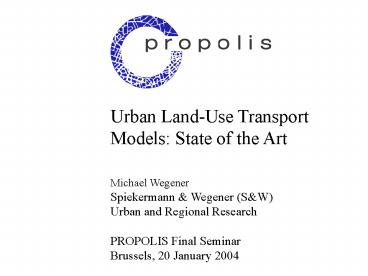Kein Folientitel - PowerPoint PPT Presentation
1 / 55
Title:
Kein Folientitel
Description:
People in the richest countries consume significantly more ... produce more greenhouse gases, noxious emissions and waste than people in the poorest regions. ... – PowerPoint PPT presentation
Number of Views:46
Avg rating:3.0/5.0
Title: Kein Folientitel
1
Urban Land-Use Transport Models State of
the Art Michael Wegener Spiekermann Wegener
(SW) Urban and Regional Research PROPOLIS Final
Seminar Brussels, 20 January 2004
2
Cities
3
1250
4
1350
5
1550
6
1750
7
1872
8
1912
1900
9
1925
10
Frank Lloyd Wright Broadacre City
1934-58
11
1960
12
1990
13
1990
14
Why?
15
The Problem It is increasingly becoming obvious
that the lifestyle practised in the cities of the
most affluent countries is not sustainable. People
in the richest countries consume significantly
more energy and resources per capita and produce
more greenhouse gases, noxious emissions and
waste than people in the poorest regions. This
imbalance has a distinct spatial and urban
dimension It is the consequence of
market-driven interaction between urban land use
and transport
16
Land-Use Transport Interaction Urban land use
affects transport The spatial separation of
human activities requires travel and goods
transport. Example Suburbanisation of cities
is connected with increasing spatial division of
labour and so mobility.
17
Land-Use Transport Interaction Urban transport
affects land use. The development of the
transport system influences the location
decisions of land-lords, investors, firms and
households. Example The private automobile has
made every corner of the metropolitan area almost
equally suitable as a place to live or work.
18
Land-Use Transport Feedback Cycle
Trans- port
Land use
19
Land-Use Transport Feedback Cycle
20
Theory
21
The Isolated State von Thünen, 1826
22
Central Places Christaller, 1933
23
Bid-Rent Theory Alonso, 1964
24
Retail Location Huff, 1964
25
Household Location Park Burgess, 1925
26
Action Spaces Hägerstrand, 1970
27
This trip pays! For these prices and this huge
choice I would drive anywhere. The travel costs
are easily recovered!
28
Integration of Land Use and Transport
Planning
29
Integration of Urban Land-Use and Transport
Planning Urban land use and transport are
closely interrelated. It is therefore
very important to forecast the likely impacts of
urban land use and transport policies.
Therefore only close integration and
co-ordination of land use and transport planning
will lead to an environmentally and socially
sustainable spatial urban development.
30
Integration of Urban Land-Use and Transport
Planning There are three principal ways to
forecast those impacts (1) Ask people ('stated
preference') (2) Observe people ('revealed
preference') (3) Mathematical models Mathematical
models are the only method by which the effects
of individual policies can be analysed keeping
all other factors fixed.
31
Urban Systems
32
Urban Systems
Speed of change
Networks
Travel
Goods transport
Population
Employment
Workplaces
Housing
Land use
33
20 Urban Models
34
20 Urban Models Boyce Anas Landis Martine
z Simmonds Abraham, Hunt Miller, Hunt et
al. Prastacos Anderstig, Mattsson Miyamoto et
al. Wegener et al. Haag Putman Donnelly,
Hunt et al. Kim de la Barra Mackett Hensher
/Ton Echenique et al. Waddell
35
20 Urban Models
36
Comprehensiveness
37
Model Structure
38
Theory
39
Equilibrium
Land use equilibrium
No land use equilibrium
40
Model technique
41
Operationality and Application
42
Future Developments
43
Future Developments Today there is a new interest
in land-use transport models - Environmental
legislation in the USA has triggered a new wave
of applications of urban land-use transport
models - In Europe, the European Commission has
funded a number of studies employ-ing urban
land-use transport models. - The MEPLAN, TRANUS
and DELTA models are being applied to an
increas-ing number of metropolitan areas.
44
Future Developments However, there are important
challenges to meet this new demand (1) The
transport submodels used by most existing
land-use transport models do not use
state-of-the-art activity-based travel modelling
techniques. (2) The spatial resolution of most
existing land-use transport models is too coarse
to model environmental impacts and environmental
feedback.
45
Activity-Based Modelling
46
Environmental Impacts/Feedback
47
Modelling environmental impacts Examples Air
distribution models modelling two- or
three-dimensional distribution of pollutants from
emission sources require raster data of emission
sources, elevation and surface characteristics
such as green space, built-up area and high-rise
buildings. Noise propagation models modelling
pro-pagation of noise from emission sources
require raster data on emission sources,
topography, land cover and sound barriers such as
dams, walls or buildings.
48
Modelling environmental feedback
No spatial disaggregation
Spatial disaggregation of output
Spatial disaggregation of input
Zonal data
Zonal data
Zonal data
Aggregate land-use transport model
Aggregate land-use transport model
Aggregate land-use transport model
Aggregate land-use transport model
Spatial disaggregation
Zonal environmental impact model
Spatial disaggregation
Microsimulation land-use transport model
Disaggregate environmental impact model
Disaggregate environmental impact model
Few impacts Limited feedback
All impacts Limited feedback
All impacts All feedbacks
49
Environmental impacts/feedback
50
Urban Land-Use Transport Models and GIS
51
GIS functions for urban models
52
Conclusions
53
Conclusions (1) Sustainability and equity issues
have led to a new interest in urban land-use
transport models. However, to provide answers to
these new policy questions poses new challenges
to urban land-use transport models. Urban
land-use transport (LT) models need to be
extended to land-use transport and environment
(LTE) models. Urban land-use transport and
environment models need to have a higher spatial
reso-lution and incorporate more disaggregate
social and economic behaviour.
54
Conclusions (2) Urban land-use transport and
environment models should show the equity effects
of urban land use and transport policies. Urban
land-use transport and environment models should
be linked with multicriteria and cost-benefit
evaluation tools. Urban land-use transport and
environment models models should apply
visualisation tools to visualise the results to
policy makers and planners.
55































